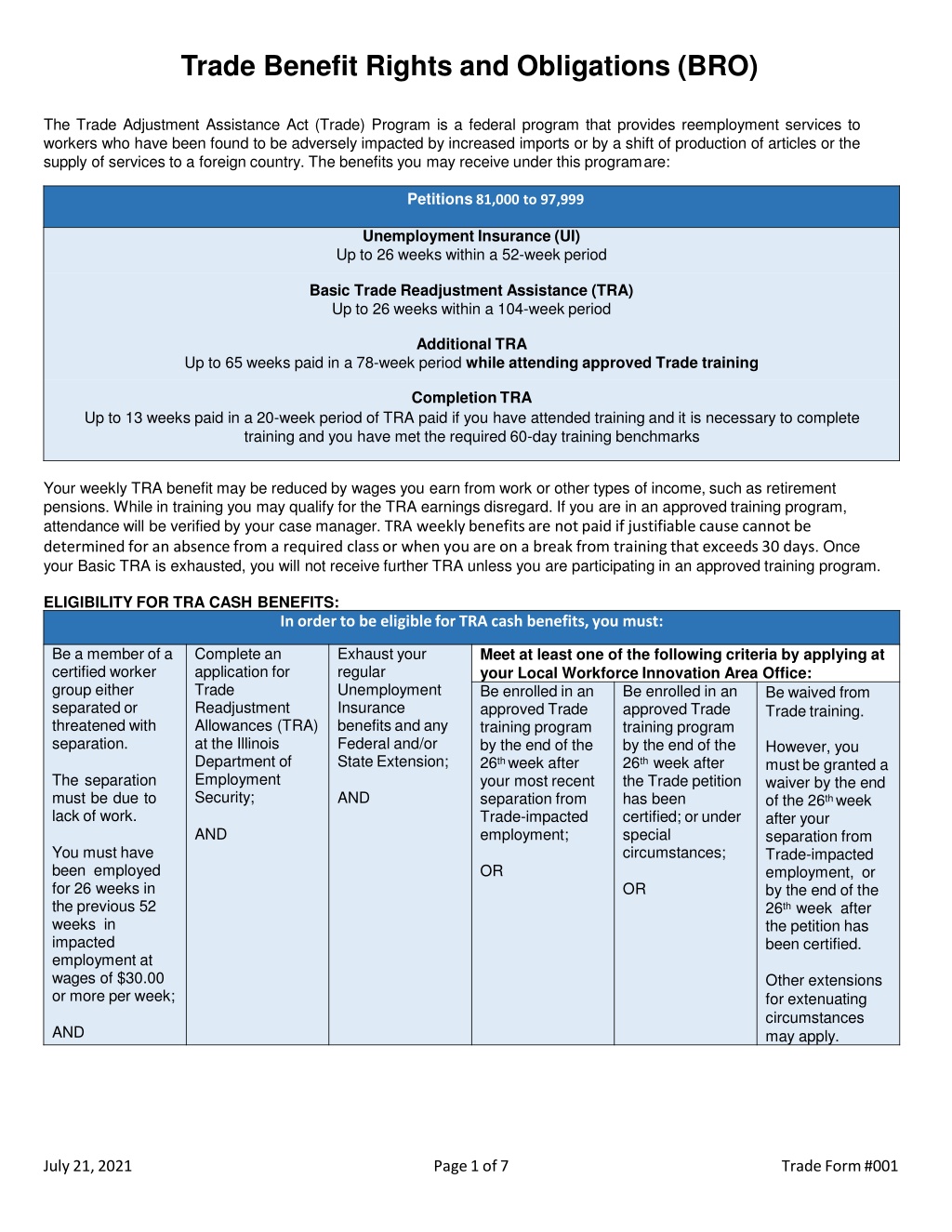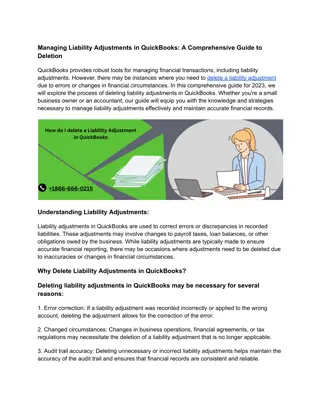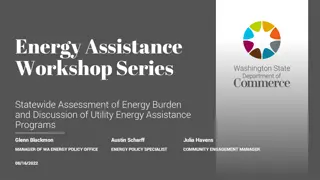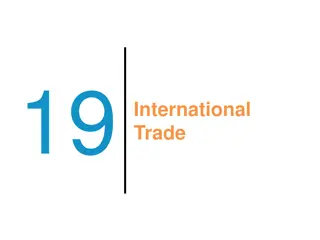Trade Adjustment Assistance Program Benefits
This federal program, known as Trade Adjustment Assistance (Trade) Program, offers reemployment services to workers affected by increased imports or shifts in production to foreign countries. Eligible individuals may receive unemployment insurance, Trade Readjustment Assistance (TRA), and other benefits to support them during training and reemployment efforts.
Uploaded on Mar 03, 2025 | 0 Views
Download Presentation

Please find below an Image/Link to download the presentation.
The content on the website is provided AS IS for your information and personal use only. It may not be sold, licensed, or shared on other websites without obtaining consent from the author.If you encounter any issues during the download, it is possible that the publisher has removed the file from their server.
You are allowed to download the files provided on this website for personal or commercial use, subject to the condition that they are used lawfully. All files are the property of their respective owners.
The content on the website is provided AS IS for your information and personal use only. It may not be sold, licensed, or shared on other websites without obtaining consent from the author.
E N D
Presentation Transcript
Trade Benefit Rights and Obligations (BRO) The Trade Adjustment Assistance Act (Trade) Program is a federal program that provides reemployment services to workers who have been found to be adversely impacted by increased imports or by a shift of production of articles or the supply of services to a foreign country. The benefits you may receive under this programare: Petitions 81,000 to 97,999 Unemployment Insurance (UI) Up to 26 weeks within a 52-week period Basic Trade Readjustment Assistance (TRA) Up to 26 weeks within a 104-week period Additional TRA Up to 65 weeks paid in a 78-week period while attending approved Trade training Completion TRA Up to 13 weeks paid in a 20-week period of TRA paid if you have attended training and it is necessary to complete training and you have met the required 60-day training benchmarks Your weekly TRA benefit may be reduced by wages you earn from work or other types of income, such as retirement pensions. While in training you may qualify for the TRA earnings disregard. If you are in an approved training program, attendance will be verified by your case manager. TRA weekly benefits are notpaid if justifiablecausecannotbe determinedfor an absence from a required class or when you are on a break from trainingthatexceeds30 days. Once your Basic TRA is exhausted, you will not receive further TRA unless you are participating in an approved training program. ELIGIBILITY FOR TRA CASH BENEFITS: In orderto be eligibleforTRA cash benefits, you must: Be a member of a certified worker group either separated or threatened with separation. Complete an application for Trade Readjustment Allowances (TRA) at the Illinois Department of Employment Security; Exhaust your regular Unemployment Insurance benefits and any Federal and/or StateExtension; Meet at least one of the following criteria by applying at your Local Workforce Innovation Area Office: Be enrolled in an approved Trade training program by the end of the 26thweek after your most recent separation from Trade-impacted employment; special circumstances; Be enrolled in an approved Trade training program by the end of the 26thweek after the Trade petition has been certified; or under Be waived from Trade training. However, you must be granted a waiver by the end of the 26thweek after your separation from Trade-impacted employment, or by the end of the 26thweek after the petition has been certified. The separation must be due to lack of work. AND AND You must have been employed for 26 weeks in the previous 52 weeks in impacted employment at wages of $30.00 or more per week; OR OR Other extensions for extenuating circumstances may apply. AND July21,2021 Page1of7 TradeForm#001
ISSUANCE OF A WAIVER FROM TRAINING Under certain circumstances, you may receive up to 26 weeks of Basic TRA while being waived from the training requirements. A career planner will assess your individual situation. A waiver will not be issued unless the Individual Employment Plan includes a valid training plan. Criteria established by the Federal government for the approval of a waiver include: A Waiver From Training Can Be Issued Based on One of These Criteria: You are in poor health (however, this only waives you from training, not from looking for work and accepting offered employment). Your first available enrollment date for training is within 60 days after the date of the waiver. Training funds are not available under Trade or other Federal programs, or suitable training is not available at a reasonable cost. Once you have been issued a Waiver, you must contact your career planner every 30 days. Failure to make contact every 30 days could be reason to revoke your waiver from training resulting in loss of any future UI/TRA payments for this certification. EMPLOYMENT AND CASE MANAGEMENT SERVICES You are entitled to be offered the following Employment and Case Management Services: Types of Case Management Services Including diagnostic testing and use of other assessment tools, in-depth interviewing and evaluation to identify employment barriers and appropriate employment goals. Comprehensive and Specialized Assessment of Skill Levels and Service Needs Development of an Individual Employment Plan Training Available Identifying employment goals and objectives, and appropriate training to achieve those goals and objectives. Information on training available in local and regional areas, information on individual counseling to determine which training is suitable training, and information on how to apply for such training. Including the referral to educational opportunity centers described in Section 402F of the Higher Education Act of 1965. You may request financial aid administrators at institutions of higher education to use their discretion in determining the amount of your need for Federal financial assistance under title IV of 20 U.S.C. 1070 ex seq. Including development of learning skills, communication skills, interviewing skills, punctuality, personal maintenance skills and professional conduct to prepare you for employment or training. How to Apply for Financial Aid Short-Term Prevocational Services Individual and Group Career Counseling Employment Statistics and Information related to local, regional, and national labor market area Supportive Services Individual career counseling, including job search and placement counseling, during the period in which you are receiving TRA or training and after receiving such training for purposes of job placement. Including job vacancy listings in such labor market areas; information on job skills necessary to obtain jobs identified in job vacancy listings in such labor markets; information relating to local occupations that are in demand and the earnings potential of such occupations and skills requirements for local occupations. Including services relating to childcare, travel assistance, dependent care, housing assistance, and needs-related payments that are necessary to enable you to participate in training. July21,2021 Page2of7 TradeForm#001
TRAINING ASSISTANCE Prior to being approved for training assistance, a career planner will assess your individual situation. The six criteria established by the Federal government for the approval of a job training plan are as follows: Criteria That Must Be Met for Approval of Training: 1) There is no suitable employment available for the trade-affected worker. 2) The trade-affected worker would benefit from appropriate training. 3) There is a reasonable expectation of employment following completion of such training. There is no suitable employment in the commuting area or another area outside the commuting area to which the worker intends to relocate and there is no reasonable prospect of suitable employment in the foreseeable future. Suitable employment, as it relates to job training assistance, is employment that pays at least 80% of the weekly wage and involves a skill level at least as great as that of the trade-impacted employment. The worker would benefit from training when the training increases the likelihood of employment. The worker must have the knowledge, skills, and abilities to undertake, make satisfactory progress in, and complete the training program. There must be a projection based on labor market conditions expected to exist upon completion of the training program, the worker is likely to find employment using the skills and education acquired while in training. 4) Training is reasonably available to the trade-affected worker. 5) The trade-affected worker is qualified to undertake and complete such training. 6) Such training is suitable for the trade-affected worker and available at a reasonable cost. In determining whether training is reasonably available, first consideration must be given to training opportunities within the commuting area. Training outside the commuting area may be approved if none is available at the time in the commuting area. Whether the training is in or outside the commuting area, the training program must be available at a reasonable cost as prescribed in Criterion 6. In determining whether the worker is qualified, states must ensure the worker s knowledge, skills, abilities, educational background, work experience and financial resources are adequate to undertake and complete the training program. In making this determination, states must consult the initial assessment, comprehensive and specialized assessment and the Individual Employment Plan (IEP). Evaluation of the worker s financial ability will include an analysis of remaining weeks of UI/TRA payments in relation to the duration of the training program. If UI and TRA payments will be exhausted before the end of the training program, a state must consider whether personal or family resources will be available to assist the worker in completing the training program. When adequate financial resources are insufficient, the training will not be approved, and consideration will be given to other training opportunities available to the worker. The state must determine that the training program being considered is appropriate given the worker s knowledge, skills and abilities, background, and experience relative to the worker s employment goal. A state must ensure and document that the training program is reasonable by researching costs for similar training programs. Expenses must be necessary for the completion of the training program. Available at a reasonable cost means that training may not be approved at one provider when, all costs being considered, training better or substantially similar in quality, content and results can be obtained from another provider at a lower total cost within a similar time frame. Training must not be approved when the costs of the training are unreasonably high in comparison with the average costs of training other workers in similar occupations at other providers. July21,2021 Page3of7 TradeForm#001
Adversely Affected Incumbent Worker Training An adversely affected incumbent worker is defined as: 1. A member of a group of workers who have been certified as eligible to apply for Trade; 2. Has not been totally or partially separated from adversely affected employment; and 3. Is determined, on an individual basis, to be threatened with total or partial separation. Adversely Affected Incumbent Worker Training Training may be approved for adversely affected incumbent workers before separation. Trade pre-separation training is intended to allow earlier intervention where layoffs are planned in advance and the employer can specifically identify which workers will be affected. On-the-Job Training (OJT) cannot be approved. Customized training may not be approved unless such training is for a position other than your adversely affected employment. The state must evaluate whether the threat of total or partial separation continues to exist for the duration of the pre- layoff training. This can be accomplished by verifying with the employer that the threat of separation still exists before each subsequent portion of the training is funded. If the threat of separation is removed during the training program, funding of the training must cease. You would be eligible to complete any portion of the training program where Trade funds have already been expended but would not be eligible for further Trade funding of the training program in the absence of a threatened or actual separation from the adversely affected employment. Trade permits approval of one training per certification. A training program begun prior to separation counts as that one training program and the training plan should be designed to meet your long-term needs based on the expectation that you will be laid off. Additional Training Requirements You are allowed to choose either part-time or full-time training, although if you are attending part-time training your eligibility for TRA and HCTC may be impacted. The training approval criteria above that apply to the approval of full-time training also applies to the approval of part-time training. Part Time vs. Full Time Training All absences must be reported to the career planner prior to the start of the training class anticipated to be missed or immediately following an unscheduled absence. Absences may result in the loss of a full week of benefits. Costs of a training program may include, but are not limited to tuition, fees, books, the usual and customary tools, equipment, supplies, uniforms, and other academic fees as part of the approved training program. All tuition, fees, books, the usual and customary tools, equipment, supplies, uniforms, and other academic fees must be listed in the syllabus as a requirement for all students in the training program. Certain training related consumables will also be an allowable expense. Participants may also be eligible for supplemental assistance (subsistence expenses and transportation expenses) outside the normal commuting area. Costs of initial licensing and certification tests and fees where a license or certification is required for employment are also an allowable expense. Training Attendance Cost of Training Requests for tools and equipment, supplies, and uniforms for electives will be evaluated on a case-by- case basis. You may be eligible for supplemental assistance. You must ensure the career planner has been provided all class schedules, grades, progress reports, attendance reports, billing information, program outcome documentation (diploma, certificate, industry recognized credentials), and any other training related documentation requested. These may be provided by either the training institution or by you. Training Documents You Must Provide Changes to your training may NOT be made by either you or the training institution without prior approval from your career planner. Prior to the approval of any training program, you are required to enter into a written agreement with the State under which Trade funds will not be applied for or used to pay any portion of the costs of the training you have reason to believe will be paid by any other Governmental or Private source. Other Training Funds July21,2021 Page4of7 TradeForm#001
Recall to Trade Employment If you are in training and receive a recall notice from your former employer, you have the right to refuse the recall and to complete the originally approved training program in which you are enrolled. If you do not successfully complete your agreed upon training plan, you may be liable for repayment of a portion of or total of the training costs. Warnings If you drop out of training completely or below the level considered full-time without justifiable cause, you may be liable for repayment of TRA benefits and training costs. If you attend any training, every 60 days you must meet established benchmarks. Those benchmarks mandate that you remain in satisfactory academic standing and on track to complete training within the agreed upon timeframe. The 1stfailure to meet established benchmarks results in a warning and instruction to contact your career planner immediately. Training Benchmarks The 2ndfailure to meet established benchmarks results in a warning and the modification of the training plan, if that is possible. Your signature on this document represents your agreement that you are aware of this requirement. All approved training must meet criteria of training (see Page 3), must meet Training Benchmarks, and must also result in Industry Recognized Credential. Completion TRA REEMPLOYMENT TRADE ADJUSTMENT ASSISTANCE (RTAA) RTAA is an alternative assistance program for older workers certified eligible to apply for Trade Adjustment Assistance. RTAA is designed to allow Trade eligible workers who find reemployment, to receive a wage subsidy of 50% of the difference to help bridge the salary gap between your old and new employment. You may be eligible for the RTAA subsidy for a period of up to two years or total payments of up to $10,000, whichever comes first. To be eligible for RTAA, you must meet the following conditions at the time of reemployment: You must be at least 50 years of age at the time of application; You must be employed on a full- time basis as defined by the law of the State in which a you are employed and are not enrolled in a training program approved under section 236; You must be employed at least 20 hours per week and enrolled in a full-time Trade approved training program approved under section 236; You cannot be employed at the firm from which you were separated. You may collect RTAA after a period of TRA, but the amount of RTAA will be reduced by the amount of TRA received. Your earnings are not more than $50,000 each year in wages from reemployment. Accordingly, this requirement means that, if the certification is issued for a worker group in an appropriate subdivision of a firm, you may not return to employment with that subdivision, but may return to work at another subdivision of the firm. And OR If, however, the certification is issued for workers in the entire firm, you may not return to employment in any subdivision of that firm. July21,2021 Page5of7 TradeForm#001
TRADE OUT-OF-AREA JOB SEARCH ALLOWANCES If you have a job interview outside the commuting area, 90% of the cost of necessary job search expenses may be reimbursed, up to a maximum of $1,250. The application for Job Search Allowances must be made and approved in advance. Criteria established by the Federal government for which the approval of Job Search Allowances can be made include: A timely filed Commerce/Trade Form #012 Application for Trade Out-of-Area Job Search Allowance. The time limitations for applying for job search allowances are 365 days (one year) after the petition certification date or your last total separation from work (whichever is later); or 182 days (6 months) after the completion of your training; You must be totally separated from the adversely affected employment when beginning the job search; Receive a determination by the LWIA that you cannot reasonably expect to secure suitable employment in the commuting area; and can reasonably expect to obtain, in the area of the job search, either: suitable employment; or employment that pays at least the 75thpercentile of national wages, as determined by the National Occupational Employment Wage Estimates, and otherwise meets the definition of suitable employment; Receive a determination by the LWIA that you cannot reasonably expect to secure suitable employment by alternatives to being physically present in the area of the job search, such as by searching and interviewing for employment by means of the internet and other technology; No prior receipt of a relocation allowance under the same certification; and Complete a state-approved job search within 30 calendar days after the worker leaves the commuting area to begin the job search. A job search is complete when the worker either: 1) obtains a bona fide offer of employment; or 2) has, with verification, contacted each employer the worker planned to contact, or to whom the LWIA or other one-stop partner referred the worker as part of the job search, whichever comes first. Travel expenses may not exceed 90% of the lesser of: a) actual travel costs; or b) the prevailing cost per mile by privately owned vehicle based on Federal Travel Regulations at www.gsa.gov, for round trip travel by the usual route from the worker s home to the job search area, though other forms of transportation may be utilized. TRADE OUT-OF-AREA RELOCATION ALLOWANCES If you obtain a bona fide offer of work outside the commuting area, and desire to move your possessions, you may file for a relocation allowance. You may be eligible for a lump sum payment equivalent to three times your average weekly wage from the adversely affected employment up to a maximum payment of $1,250. The application for relocation allowances must be made and approved in advance. Criteria established by the Federal government for which the approval of a relocation allowance can be made include: A timely filed Commerce/Trade Form #013 Application for Trade Out-of-Area Relocation Allowance. The time limitations for applying for out-of-area relocations are 425 days after the petition certification date or 425 days after the date of your last total separation from work (whichever is later); or 182 days after the completion of your training; You must be totally separated from the adversely affected employment when beginning the relocation; No prior receipt of a relocation allowance under the same certification; A determination by the LWIA that you have no reasonable expectation of securing suitable employment in the commuting area, and has obtained either suitable employment or employment that pays a wage of at least the 75thpercentile of national wages, as determined by the National Occupational Employment Wage Estimates, and otherwise meets the suitable employment requirements, or a bona fide offer of such employment, in the area of intended relocation. You must begin the relocation as promptly as possible after the date of certification but no later than: 1) 182 days after the worker filed the application for a relocation allowance; or 2) 182 days after the conclusion of an approved training program, if the worker entered a training program that received supplemental assistance (subsistence and/or transportation payments) for training outside the worker s commuting area; and Complete a state-approved out-of-area relocation within a reasonable time as determined in accordance with Federal Travel Regulations, with the State giving consideration to, among other factors, whether: 1) suitable housing is available in the area of relocation; 2) the worker can dispose of the worker s residence; 3) the worker or a family member is ill; and 4) a member of the family is attending school, and when the family can best transfer the member to a school in the area of relocation. Relocation within the United States and outside your present commuting area; Applications for relocation allowances and a job search allowance may not be approved concurrently, but the prior payment of a job search allowance shall not otherwise preclude the payment of a relocation allowance. July21,2021 Page6of7 TradeForm#001
Health Coverage Tax Credit (HCTC) Health Coverage Tax Credit (HCTC) - HCTC was established to subsidize private health insurance costs. It is a 72.5 percenthealth coveragetax credit available throughDecember31,2021, for eligible TRA and RTAA recipients. Part-time training and work-based training may affect HCTC eligibility. More information and updates can be found at the IRS website at: http://www.irs.gov/HCTC OBLIGATIONS You understand that you must report all information accurately to the best of your knowledge and that you do so with no intent to commit fraud. Furthermore, you understand that falsifying information or using the funds other than for the intended purposes is felony theft and is punishable under state law by up to 7 years in prison and fines of up to $25,000. Violators may also face federal felony charges. I HAVE DISCUSSED THE POINTS OF THIS BENEFITS RIGHTS AND OBLIGATIONS STATEMENT WITH THE PARTICIPANT LISTED BELOW: Career Planner Signature Date I HAVE RECEIVED A BENEFITS RIGHTS AND OBLIGATIONS STATEMENT AND I UNDERSTAND ALL POINTS HEREIN LISTED. THE ADDRESS ON RECORD WILL BE USED TO NOTIFY ME OF IMPORTANT DETAILS CONCERNING MY BENEFITS AND SERVICES. I UNDERSTAND IT IS MY RESPONSBILITY TO INFORM MY CAREER PLANNER OF ANY ADDRESS CHANGES OR CHANGES IN CONTACT INFORMATION. Participant Name (Print) / / ParticipantSignature Date XXX-XX- Social Security Number Appeal Rights If you disagree with this determination, you may complete and submit a request for reconsideration/appeal. A letter will suffice if you do not have an agency form. Your request must be filed with the Illinois Department of Employment Security ( IDES ) within thirty (30) calendar days after the date at the top of this letter. If the last day for filing your request is a day that IDES is closed, the request may be filed on the next day that IDES is open. Please file the request by mail to: IDES P.O. Box 19509 Springfield, IL 62794 or fax to: 217-557-4913. Any request submitted by mail must bear a postmark date within the applicable time limit for filing. July21,2021 Page7of7 TradeForm#001























